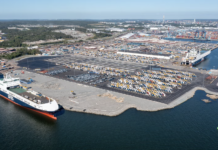
International Container Terminal Services Inc. (ICTSI) has rolled out further improvements and upgrades at its flagship Manila International Container Terminal (MICT), including environmentally sustainable initiatives.
In particular, ICTSI is tracking the second phase of development of MICT’s Berths 7 and 8, which will include the preparation of backup areas for the future Berths 9 and 10.
ICTSI has also announced the refurbishment of Berths 1 to 5, as well as their backup areas, including the installation of an additional 450 reefer plugs for 40 footers, and upgrading the yards of the Berths.
The upgrades, according to the Philippine port operator, are designed to further ease transactions and ensure stakeholder needs are addressed and provide added safety and security for all port stakeholders.
In the meantime, ICTSI is also planning to acquire eight new hybrid rubber-tired gantries (RTG) as a complement to the current fleet of 32 hybrid RTGs, firstly acquired in 2018, that are expected to further reduce emission by 50% compared to the previous RTGs.
The eighth busiest port and terminal operator in the world will also decommission MICT’s first quay crane this year, which will be replaced over the next three years by three new quay cranes, all of which are capable of servicing larger vessels of over 12,500TEU capacity.
Meanwhile, the terminal in Manila has recently upgraded its equipment, including the replacement of its yard and crane lights with more energy-efficient LED lighting systems, which are expected to save around 1.8 million kWh per year and offset up to 1.09 million tons of carbon dioxide.
“We continually invest in port infrastructure and facilities that enhance our operational efficiency while simultaneously helping minimise our environmental impact,” stated Christian R. Gonzalez, ICTSI executive vice president.
A substantial part of the ICTSI Group’s 2022 budget has been committed for these Manila Terminal’s upgrades that are anticipated to further strengthen its capacity to serve effectively the world’s larger boxships and upcoming increasing volumes.
Furthermore, cameras have already been installed at the Pasig River, the Philippine capital’s main waterway, as part of preliminary work for the Foundation’s partnership agreement with Finnish Non-Governmental Organisation RiverRecycle, to pioneer a sustainable river waste collection system for MICT’s immediate communities.
To address the potential issue of ballast water contamination from foreign ships, the Foundation and the Diliman Science Research Institute test prototypes for the Foundation’s Water Ballast Treatment System Project, which, upon completion, can easily be carried on and off large cargo vessels visiting MICT to decontaminate ballast water prior to release into the sea.
Moreover, another truck gate equipped with optical character recognition was made operational last April with additional automation for enhanced gate service, to further improve the mobility of trucks inside the ICTSI Manila terminal.
Last but not least, the terminal of Manila continues to engage with the Bureau of Customs to improve services in relation to the unimpeded and online release of cargo release to include reduced releasing time from filing of entry and more seamless X-ray and inspection procedures, according to a statement.
Despite the effects of ongoing global supply chain disruptions affecting major hubs, yard utilisation at ICTSI’s flagship continues to be manageable, according to data from the Philippine Ports Authority (PPA). As of PPA’s September 2021 Performance Report, MICT’s average yard utilisation is at 63.02%.








